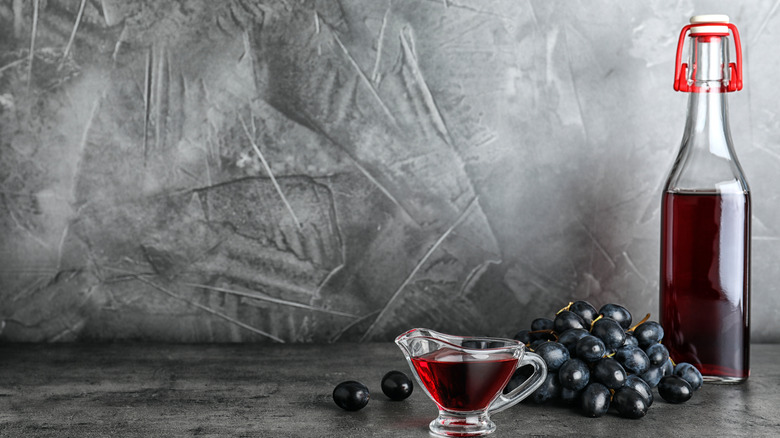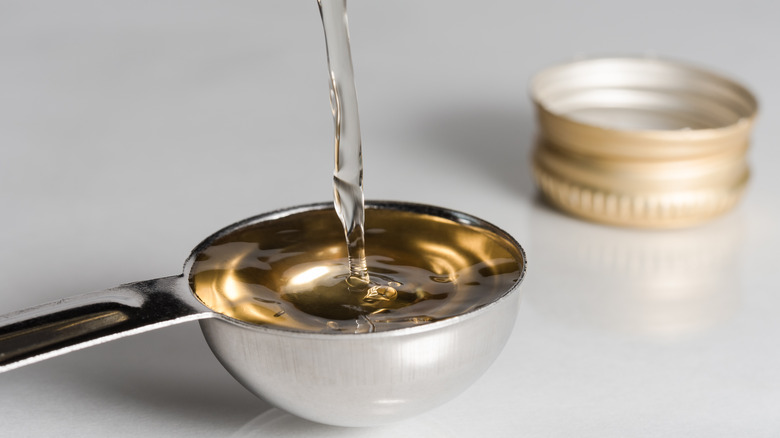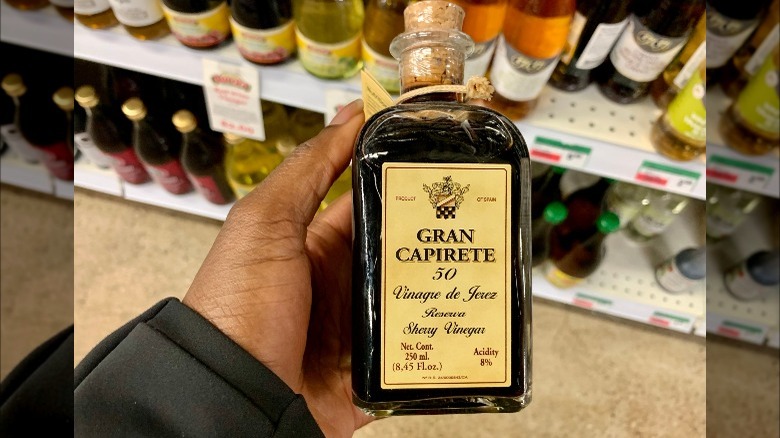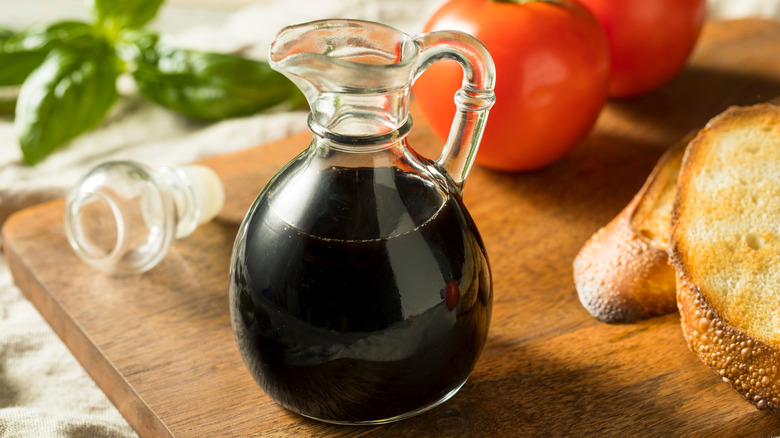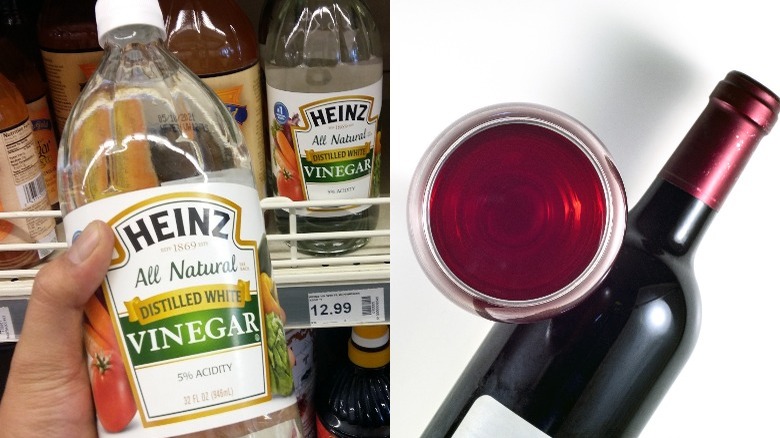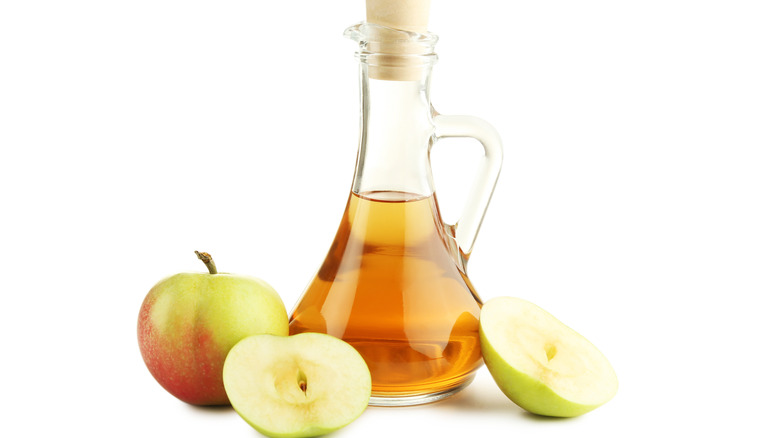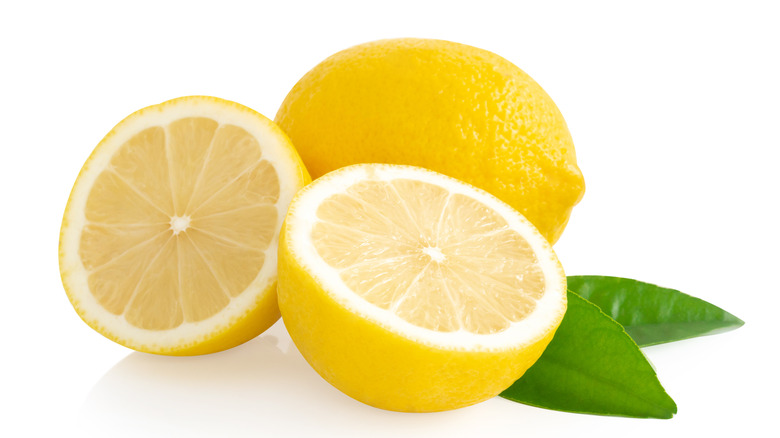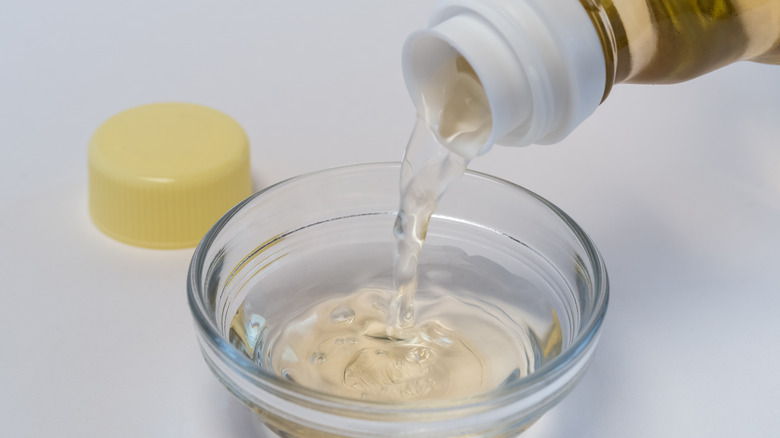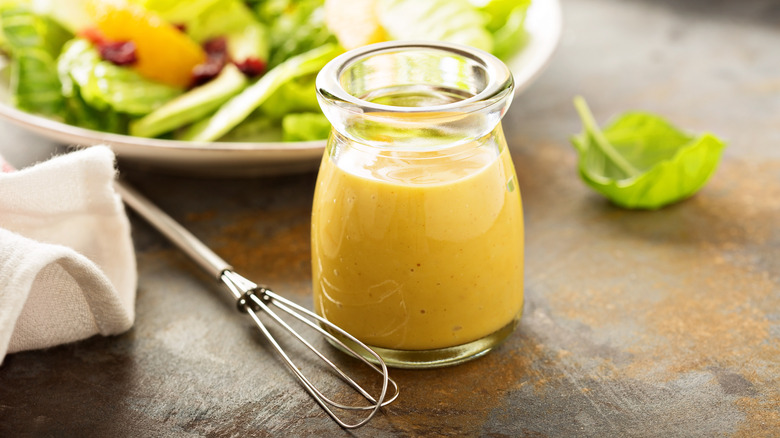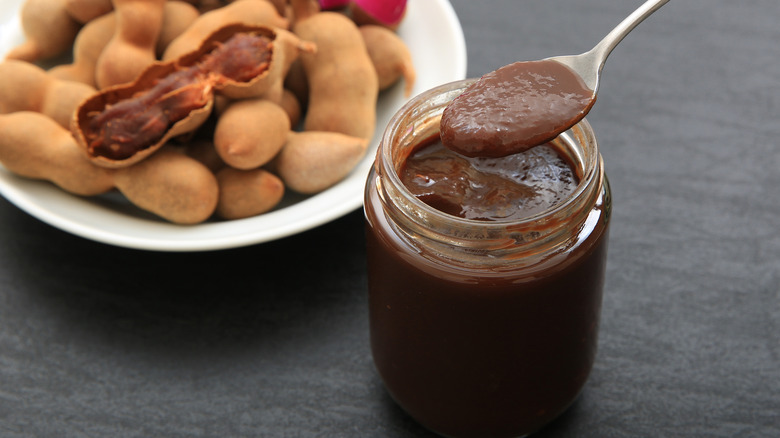10 Best Substitutes For Red Wine Vinegar
Determining which bottles of vinegar belong in your pantry can be a slightly overwhelming task. There seems to be an endless number of varieties available, and while they're all similar in that they have a potent smell that can quickly fill a room, each type has a distinct flavor that can be a crucial component in a recipe.
Of the many types of vinegar out there, red wine vinegar is a must-have, especially if you're big on making your own dressings and marinades. The bright red liquid is a product of fermented red wine (who would've thought?) that Healthline says has been strained and typically aged to its ideal acidity, which culinary scientist Jessica Gavin notes is around 7%. Along with its bold tanginess, this product also has a slightly fruity taste that lends itself nicely to red meats and vegetables, as well as beans, soups, and gazpachos (via Bon Appétit). In summation, red wine vinegar is a versatile ingredient that will add a flavorful punch to whatever recipe you're using it in.
Red wine vinegar is readily available for purchase in just about any grocery store. However, if you happen to find yourself low or completely out of the ingredient when in the middle of cooking, there are plenty of viable substitutes for the tangy liquid that you could use instead.
1. White wine vinegar
Though red and white wines are wildly different in a number of ways, their vinegar counterparts can be interchangeable when used for the right reasons. While white wine vinegar isn't quite as potent, The Kitchen Community still labels it the "easiest" substitute for the red stuff, as the two are similar in acidity as well as consistency and density. When substituted in something like a salad dressing, Cook's Illustrated notes that most will likely not even be able to determine that the swap has been made. Even if presenting the substitution to someone that knows their vinegar, the eater may only notice a "brighter" flavor.
Of course, white wine vinegar will not be able to provide the vibrant coloring that red wine vinegar has, so this swap isn't feasible if that is the purpose for its use in the recipe in the first place. However, if you're simply looking for a similar flavor, it can easily be subbed in at a 1:1 ratio (via Pure Wow).
2. Red wine
Red wine is an obvious option if the vinegar version of it is not available for use, but don't expect quite the same results. Vino can be used if your recipe needs red wine vinegar for its deep and slightly fruity flavor, but without the fermentation process, the acidic component of the ingredient is lost (via Oola). Therefore, the swap will work fine for a marinade, but might not be the best substitution when the vinegar is needed for its acidity in a dressing or pickling liquid. When it is the flavor component that your recipe needs, The Kitchen Community suggests using a wine like an Argentinian Malbec, which is strong and rich and tannins, and will create a similar taste that would initially be brought by red wine vinegar.
The alcohol content in red wine plays a major factor in how much should be used in place of red wine vinegar. Per Fitibility, you'll need to at least cut the amount of red wine vinegar your recipe calls for in half if making this swap. For best results, however, it may better to start with an even smaller amount of red wine and gradually add more in small amounts until your desired flavor is attained, per The Kitchen Community.
3. Sherry vinegar
Also a member of the wine vinegar family, sherry vinegar is another possible alternative when there's no red wine vinegar on hand. It is a product of fermented sherry wine, which Bon Appétit notes is made from grapes native to Spain — though the specific type of grape can alter its flavor profile as well as drive up the cost. Therefore, a "younger" variety may be best for both your recipe and your wallet with the added bonus of giving whatever you're making a "fancier" taste that The Kitchn describes as "complex." Chef's Pencil notes that it works well when utilizing "dry heat techniques" like grilling or roasting for meats or veggies, while The Kitchen Community suggests it for vinaigrette because of the "underlying tartness" and sweetness it provides.
Like white wine vinegar, sherry vinegar can be substituted for red wine vinegar at a 1:1 ratio, though you may need to alter your recipe in other ways to perfectly pull this swap off. As Foods Guy explains, you'll want to reduce the other sweet-tasting components on your ingredient list so as not to lose the acidic component of the vinegar.
4. Balsamic vinegar
If you're a big fan of Caprese salads, you already know what balsamic vinegar tastes like. A rich, brown liquid hailing from Modena, Italy, this variety of vinegar is similar to sherry vinegar in that it is milder and sweeter than red wine vinegar (via Oola), but it is still a possible solution when needing a replacement for the ingredient, especially when it's for an Italian dish.
Balsamic vinegar will work in salad dressings, where Pure Wow says you can use the same amount as red wine vinegar that your recipe calls for. The Italian product can be used in marinades for meats and vegetables as well, though you'll want to cut the initial measurement in half, or possibly a bit more, to make sure your dish doesn't get overly sweet. Per Oola, you may also have to employ the same method explained in the above sherry vinegar section by cutting out the extra sweeteners in your recipe, or even add a dash of lemon juice to bring out the acidity from the balsamic vinegar more.
5. White vinegar and red wine
We've already explained the pros and cons of using red wine in place of red wine vinegar, but to recap: vino will work as a substitute when needed for its flavor, but will not bring the same amount of acidity to your recipe as the vinegar will. Fortunately, there is an easy way to get the best of both worlds by simply combining red wine with another pantry staple — white vinegar.
Putting together this substitution is simple. Per Pure Wow, you can use a 50/50 blend of white vinegar and red wine to make up the same amount of red wine vinegar that is called for in your recipe. So, for example, if you need 3 tablespoons of red wine for a marinade, mix together 1 ½ tablespoons of red wine and 1 ½ tablespoons of white vinegar to make a suitable replacement.
It is important to note that this mixture calls for white vinegar, not white wine vinegar. That is because white vinegar is made from distilled water and acetic acid rather than fermented white wine (via In The Wash). It is a bit more acidic and does not have the same fruity notes as the booze-based ingredient, so it will not compete with the flavors needed from the red wine.
6. Apple cider vinegar
Hmm, another type of vinegar that will work in place of red wine vinegar ... who would've thought? But while apple cider vinegar can be used in a pinch if you're low on the red stuff, it's not quite as versatile as some of the other options on this list. Unlike the aforementioned wine vinegars, apple cider vinegar is made from fermented apple juice rather than vino (via WebMD), giving it a much fruitier taste that Oola says will work exceptionally well in vinaigrettes that originally called for red wine vinegar.
Apple cider vinegar falls higher than red wine vinegar on the sweetness scale, but The Kitchen Community has an easy trick to ensure your recipe won't turn out overly sweet. Per the outlet, use three parts apple cider vinegar and one part red wine when opting for this replacement in dressings. The combination may also work well for savory recipes in different increments — try experimenting when the two and see what you can come up with!
7. Lemon juice
If you're in a serious bind and find your entire vinegar collection completely depleted, lemon juice, or even lime juice, can work in place of red wine vinegar. Widely used in cooking as an acidic element to a dish, Food Guys explains that this swap will work best if the recipe you're following relies on red wine vinegar for its own acidic element and only calls for a small amount of it in the first place. The Stone Soup notes that this option will also provide a nice freshness to your dish that might work exceptionally well in a salad dressing, but if it's ultimately the rich flavor of red wine vinegar that your food needs, go ahead and find another option on this list to use.
For times when lemon juice does seem like the right swap to make, remember that it has powerful sourness that can ruin your dish if too much is used. Oola suggests starting with only a small amount of the citrusy fruit juice when using it as a sub and slowly add more until the desired level of acidity is achieved.
8. Rice vinegar
Let's start by clearing one thing up: rice vinegar and rice wine vinegar are the same things, but rice wine is not. Rice vinegar and rice wine vinegar can be used as a substitution for red wine vinegar, but rice wine cannot. Cool? Cool. Let's move on.
According to Lifehacker, rice vinegar is made from fermenting the sugars found in rice, turning it into wine. The wine is then further fermented to become an acetic acid, resulting in a tangy rice vinegar that The Kitchen Community says isn't quite as flavorful as red wine vinegar but can still be a suitable replacement. More specifically, this product will work particularly well in marinades and vinaigrettes that incorporate other strong flavors, as they won't be overpowered by the rice wine.
Food Guys suggests starting off by using the same amount of rice vinegar as red wine vinegar that your recipe calls for. However, keep the bottle on hand, as you'll probably end up wanting to add a bit more to the dish to get the flavors as close to the original as possible.
9. Champagne vinegar
Champagne vinegar is made using the same method as wine vinegars but, as its name implies, it has champagne at its base rather than vino. Described by Food Champs as having a "zesty" flavor along with a "slight hint of vanilla," and though it is slightly milder than red wine vinegar, it can still be used as a substitution. However, there's no need to rush out to the store and grab a bottle to keep on hand if the situation occurs — champagne vinegar can be on the pricier side, and there are a number of other options on this list with a price tag that won't make you cringe.
If you do happen to have a bottle of champagne vinegar in the back of your pantry, this is an easy substitution that Chef's Pencil says can work well in things like a hollandaise sauce, vinaigrette, or an infusion. Start off by swapping champagne vinegar for red wine vinegar in a 1:1 ratio, but don't be afraid to use a little more if you feel that your dish is lacking (via The Stone Soup).
10. Tamarind paste
Tamarind paste is a popular ingredient in Asian and Indian cuisine, and works as a possible substitution for red wine vinegar — but not in every situation. The product comes from the tamarind fruit, and, according to Foods Guy, has an acidic and slightly sour taste that can mimic that of red wine vinegar along with the added bonus of being high in antioxidants. You may be able to find tamarind paste at your usual grocery store but may fare better at a specialty store like H Mart, or even Amazon.
Tamarind paste will work best as a meat tenderizer or a marinade for meats and seafood because it also contains tartaric acid. However, while its acidity can compare to red wine vinegar, it does have a strong flavor that can be overpowering in whatever it is that you are making. Per Organic Facts, start off with only a small amount when making this swap, adding more in tiny increments if needed so as not to potentially overwhelm your dish.
